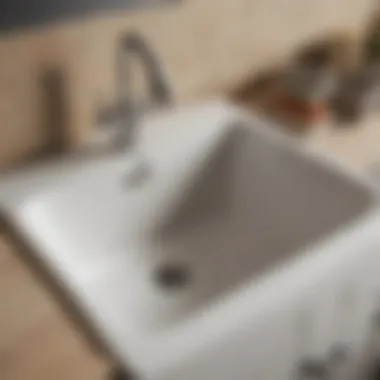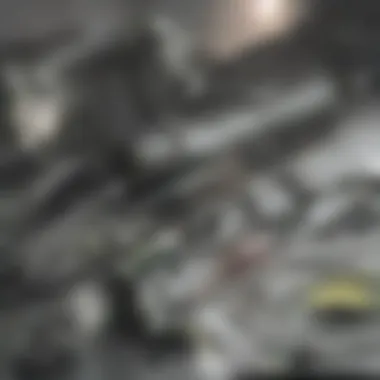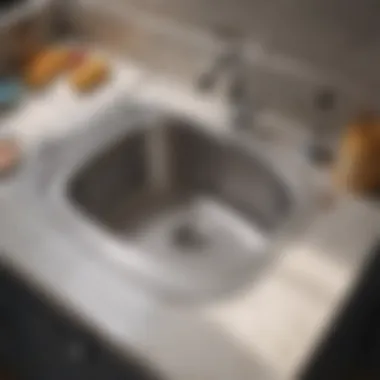Effective Ways to Unclog Your Laundry Sink


Intro
Clogged laundry sinks are a common issue in homes. They can happen unexpectedly and lead to inconvenience. Understanding how to address this problem is essential. This comprehensive guide offers practical methods to help you deal with blockages effectively. Whether you are new to home repairs or have experience, the instructions here can assist you in resolving the problem.
Understanding Clogs
To unclog a laundry sink efficiently, one must first identify the cause. Common reasons for a blockage include:
- Hair and debris: Washing clothes can lead to accumulation of dirt, lint, and hair over time.
- Grease buildup: Detergents and fabric softeners can form residues that contribute to clogs.
- Foreign objects: Causes might be items unintentionally dropped into the sink.
Recognizing these factors can guide your approach to unclogging.
Tools You Will Need
Before starting the unclogging process, gather the necessary tools. Having the right equipment can simplify the task:
- Plunger: A standard plunger can create a vacuum effect to dislodge stubborn clogs.
- Drain snake: This tool can reach deeper into the pipes, removing obstructions.
- Bucket: Useful for containing any water overflow during the process.
- Baking soda and vinegar: These natural solutions can help break down blockages chemically.
Steps to Unclog Your Laundry Sink
Initial Assessment
- Check the Sink: Inspect the sink for any visible blockages. Remove any debris you can see.
- Use the Plunger: If the sink is full, use a bucket to remove excess water. Position the plunger over the drain and push down forcefully.
- Monitor Results: After plunging, check if the water drains properly.
Advanced Techniques
If the plunger does not work, try these additional methods:
- Drain Snake Usage: Insert the drain snake into the pipe. Turn the handle while pushing it forward. This can remove deeper blockages.
- Baking Soda and Vinegar Method: Pour one cup of baking soda followed by one cup of vinegar into the drain. Wait for about 30 minutes, then flush with hot water.
- Clean the Trap: If the clog persists, remove the P-trap under the sink. Clean out any built-up gunk and reassemble.
Preventative Maintenance
Preventing future clogs is as essential as fixing current ones. Consider the following practices:
- Regular maintenance: Monthly inspection and cleaning can help catch clogs early.
- Use drain screens: Blocking larger debris can prevent many problems.
- Be mindful of what goes down the drain: Avoid washing items that can lead to obstructions.
"Regularly caring for your plumbing can save you a lot of time and effort in the long run."
End
Unclogging a laundry sink may seem daunting. Yet, with the right steps and tools, it is manageable. Understanding the causes and maintaining the system is essential for ensuring a smooth experience. By following this guide, you can prevent future issues, allowing your laundry tasks to run efficiently.
Learn more about home maintenance on resources such as Wikipedia, Britannica, and engage in discussions on Reddit.
For further inquiries or to share experiences, connect with others on Facebook.
Preamble to Laundry Sink Clogs
A clogged laundry sink can disrupt daily routines, making laundry chores more cumbersome. Understanding the significance of a functional laundry sink is paramount. When it is working correctly, it facilitates the easy disposal of water and waste generated from washing clothes, rinsing items, and other related tasks. If the sink is not functioning, it can lead to larger plumbing issues and unwanted water damage. Moreover, knowing the common causes of clogs is critical. This knowledge not only helps in early detection but also in taking proactive measures to prevent clogs from occurring.
Understanding the Importance of a Functional Laundry Sink
Having a properly working laundry sink plays a crucial role in your home management. It serves multiple functions, from cleaning delicate items to disposing of dirty water. A functional sink contributes to a tidy laundry space and can improve sewage flow in your plumbing system as well. When the sink is clogged, it may cause backups, leading to unpleasant odors and an unhygienic environment. Addressing these issues promptly ensures that laundry tasks remain efficient and hassle-free.
Common Causes of Clogs in Laundry Sinks
Several factors contribute to clogs in laundry sinks, and being aware of these can help you prevent future issues.
Hair buildup


Over time, hair can accumulate in the sink's draining system. This is particularly true if the laundry sink is used for rinsing hair or cleaning items like brushes. Hair is a significant contributor to clogs because it can bind with soap residue, forming blockages that are difficult to remove. Therefore, addressing hair buildup regularly can help maintain clean drainage pathways.
Soap residue accumulation
Soap residue can build up over time in drains, especially when using bar soaps or liquid soaps that do not dissolve easily. This accumulation can coat the inner walls of the pipes and trap other debris, leading to clogs. Maintaining clearance in the drain will help in ensuring that soap does not cause future issues. Regular cleaning schedules can help mitigate this problem, making it easier to maintain a functioning sink.
Foreign object obstruction
Sometimes, small foreign objects can accidentally make their way into the laundry sink. Items like lint, small coins, and even bits of fabric can lead to significant obstructions. These foreign objects can be troublesome to remove. When they lodge in the sink's plumbing, they often require careful inspection and sometimes professional help. Keeping an eye on what goes down your laundry sink can prevent foreign object-related clogs.
Identifying the Type of Clog
Identifying the type of clog is a crucial step in effective unclogging of a laundry sink. Recognizing the symptoms of a clogged sink allows homeowners to tailor their approach. A well-informed strategy minimizes damage and increases the efficiency of the resolution process. Knowing the distinction between slow drainage, water backup, and unusual odors can guide homeowners toward selecting the right method for clearing the clog.
Signs of a Clogged Laundry Sink
Slow drainage
Slow drainage is one of the first signs indicating a clogged laundry sink. It often results from debris or buildup in the pipes. This condition leads to frustration, especially during laundry routines. When water does not flow freely, it reflects an underlying issue that requires attention. The benefit of noting slow drainage is that it acts as an early warning system. One can address minor issues before they escalate into more significant blockages. However, slow drainage can easily be overlooked in busy households, leading to more severe complications over time.
Water backup
Water backup occurs when the water levels rise within the sink rather than draining as expected. This sign is indicative of a more severe clog than merely slow drainage. By recognizing this issue, homeowners can understand that immediate intervention is necessary. Water backup can lead to mess and potential water damage if left unaddressed. The unique aspect of water backup is its ability to disrupt laundry tasks quickly, emphasizing its significance in the overall topic of unclogging.
Unusual odors
Unusual odors emanating from a laundry sink can signify organic material breakdown, usually trapped in the drain. This aspect of a clog is quite telling as it points to stagnation and potential health hazards. Being aware of unusual odors can motivate homeowners to minimize future risks. These smells not only disrupt the laundry experience but also hint at the need for swift action. A notable feature of unusual odors is that they often accompany visible signs of blockage, creating a more comprehensive picture of the clog's nature.
Assessing Blockage Severity
Partial clogs
Partial clogs are less severe than complete blockages but still warrant attention. They allow some water to drain while causing delayed response. Partial clogs can grow if not resolved, risking a full obstruction in the future. Understanding the partial nature of a blockage helps in choosing appropriate unclogging tools and methods. It also gives the homeowner a sense of security that immediate attention can resolve the issue without overwhelming urgency.
Complete blockages
Complete blockages present a more daunting challenge as they prevent any drainage whatsoever. A complete obstruction demands immediate intervention to restore functionality. The identification of a complete blockage typically relies on several preliminary signs, including both slow drainage and water backup. The unique aspect is that it leaves no room for delay in intervention, making it a top priority in plumbing maintenance. Addressing complete blockages may require more effort or professional assistance, depending on the severity.
Tools Required for Unclogging
Understanding the tools needed for unclogging a laundry sink is essential for success in this task. Having the right instruments can make a significant difference, ensuring that you can tackle various types of clogs effectively. Each tool serves a unique purpose, and familiarity with these can simplify the process. Choosing the correct tool increases your efficiency and reduces the likelihood of causing further damage to the plumbing system.
Basic Tools for the Task
Plunger
The plunger is a fundamental tool for unclogging any type of sink, including laundry sinks. Its design involves a rubber cup that creates suction against the drain. When used correctly, it can dislodge blockages quickly. The key characteristic of a plunger is its simplicity, making it a popular choice among homeowners. It requires no special skills or materials, just a bit of physical effort.
The unique feature of a plunger is its ability to generate suction, allowing it to force water and air through the drain. This action can free clogs caused by hair, soap residue, or minor foreign objects. However, it's essential to use a plunger designed for sinks as opposed to one for toilets, as the flanging may differ. Conversely, plungers may not work effectively on more stubborn blockages, such as those formed deeper in the plumbing.
Plumbing Snake
A plumbing snake, or drain auger, is another tool that is beneficial for unclogging laundry sinks. This tool is a flexible, coiled wire that can navigate through pipes and reach deeper clogs that are beyond the reach of a plunger. The plumbing snake excels where simpler methods may fail, making it a crucial resource in your toolbox.
The key characteristic of the plumbing snake is its ability to penetrate deep into the plumbing system. It can break apart clogs or retrieve foreign obstructions that are causing the blockage. Its unique feature is its versatility; it can be used in various plumbing situations, not just laundry sinks. One disadvantage of using a plumbing snake is that it requires a bit more technique to use than a plunger, and improper use could potentially cause damage to pipes.
Bucket
Lastly, a bucket is a necessary tool for any unclogging job. When water backs up in the laundry sink, having a bucket nearby allows you to manage overflow and keep the work area clean. The key characteristic of a bucket is its capacity to collect water and debris, facilitating a more organized unclogging process.


The unique feature of a bucket is its simplicity and effectiveness for containment. It allows for easy disposal of any materials that you remove from the drain. While a bucket may not seem like a direct solution to a clog, it is indispensable for managing the aftermath of clog removal efforts. Without it, you may end up creating more mess than you need to address.
Chemical Drain Cleaners: Pros and Cons
Chemical drain cleaners offer a quick fix for stubborn clogs. However, their use must be weighed carefully against potential drawbacks. Pros include convenience and ease of use; they can dissolve certain types of blockages without physical labor. However, their cons include the risk of damaging pipes or harming the environment. It is crucial to follow the instructions carefully and consider alternatives like mechanical tools first.
Always consider a more mechanical method when dealing with heavy clogs to avoid damaging your plumbing system.
Understanding these tools and their applications can empower you as you approach the task of unclogging a laundry sink.
Step-by-Step Unclogging Methods
Addressing clogs in a laundry sink can be daunting for many homeowners. Understanding effective methods is crucial. You need to approach this task methodically to avoid worsening the situation. Each method has its own merits and challenges. Knowing when and how to use these techniques can save time, energy, and prevent further issues.
Using a Plunger Effectively
The plunger is a standard tool found in many homes. Its simplicity makes it a go-to solution for initial attempts at unclogging. The suction created helps dislodge minor blockages.
- Preparation: Ensure the sink has enough water to cover the plunger's rim. This water will enhance the suction power.
- Positioning: Place the plunger over the drain. Make sure it's sealed well to create proper suction.
- Action: Push down and pull up rapidly, repeating this motion several times. The energy exerted will often displace any blockage present.
- Result Check: After a few vigorous presses, remove the plunger and observe if the water drains away. If it does, the clog may be cleared. If not, consider trying a plumbing snake next.
This method is often effective for partial clogs. It is also the least invasive approach, making it suitable for most homeowners.
Employing a Plumbing Snake
If basic plunging doesn’t yield results, a plumbing snake may be necessary. This tool is effective for deeper or more stubborn clogs.
- Insertion: Insert the end of the snake into the drain. Feed it gradually while turning the handle.
- Navigating the Pipes: As you push, you might encounter resistance from a blockage. Continue to turn the snake while applying moderate pressure.
- Dislodging: When you engage the clog, you may feel the tool break through. Pull back slightly to remove debris and continue this process until you feel the blockage clear.
- Finish Up: Once resistance dissipates, withdraw the snake carefully. Run hot water into the sink to help clear any remaining debris.
This method can tackle clogs more effectively than a plunger, especially when hair or soap residue are involved.
Attempting Chemical Drain Cleaners
Chemical drain cleaners are another option for unclogging. These products can break down organic matter, making them useful for certain clogs.
- Choose Wisely: Select a cleaner that is appropriate for your plumbing. Always check for compatibility with your specific pipes.
- Usage: Follow the instructions on the packaging carefully. Wear gloves and ensure the area is well-ventilated.
- Time to Work: Allow the cleaner to sit as directed. This waiting period lets the chemicals break down the clog.
- Flush with Water: After the timer, flush the drain with hot water to wash away the residues.
Be cautious with this method. Overuse or incorrect application can damage pipes. Therefore, consider it a last resort after other methods have failed.
Manually Removing Blockages
In some cases, direct removal might be required, especially for solid objects causing blockages. Here’s how to proceed:
- Preparation: Gather appropriate tools like rubber gloves, a bucket, and possibly a screwdriver for removing traps. Ensure you have plenty of towels or rags on hand.
- Access the Trap: Locate the P-trap under the sink. This is usually a U-shaped pipe that often captures debris. Place a bucket underneath to catch any spills.
- Disassembly: Carefully unscrew the trap. Remove the debris trapped inside. Often, you may find hair or foreign objects.
- Reassemble and Test: After cleaning, reassemble the trap and test the flow with hot water.
Manually removing blockages is effective but can be messy. Always assess whether this step is suitable, especially if other methods are also effective.
Remember: Each method has strengths and weaknesses. Sometimes, a combination might be necessary to achieve a clog-free sink.
Engaging with these methods can provide a comprehensive approach to unclogging your laundry sink. Assess the situation before choosing the best route to ensure effective results.
When to Call a Professional
In the process of tackling clogs in a laundry sink, homeowners may often hesitate before seeking professional help. However, assessing when to call a professional is crucial to both resolving the issue effectively and avoiding further complications. A professional plumber has the skills and tools that an average homeowner may lack, making their expertise invaluable in complex situations. Let’s examine why recognizing the right moment to consult a professional is essential for maintaining a smoothly functioning laundry sink.
Recognizing Complex Issues
Not all clogs are created equal. It is vital to differentiate between simple obstructions and more complicated plumbing problems. If you encounter stubborn clogs that persist despite your best efforts, it may signal a deeper issue within the plumbing system.
Some signs that indicate a complex problem include:


- Multiple affected fixtures: If other fixtures in your home, such as the bathroom sink or shower, are also draining poorly, it may suggest a broader issue with your plumbing system.
- Pervasive odors: A foul smell coming from the sink or the drains could signal a problem beyond a mere clog, possibly indicating a sewage issue.
- Frequent backups: Constant clogs can indicate a broken or compromised pipe that needs immediate attention.
If any of these signs are present, enlisting a professional's expertise is strongly advised. Their experience allows for a precise diagnosis and effective solutions, potentially saving you time and money in the long run.
Understanding the Risks of DIY Solutions
While DIY solutions can be effective for various household problems, they come with their own risks. Attempting to unclog a laundry sink without proper knowledge may lead to further damage, unpleasant messes, or expensive repairs.
Here are some common risks associated with DIY unclogging methods:
- Pipe damage: Using excessive force with tools like plungers or snakes can severely damage pipes, causing leaks or total breaks.
- Chemical exposure: Overusing chemical drain cleaners might cause health hazards and chemical burns. Additionally, improper usage can damage the plumbing infrastructure rather than fix it.
- Wasted time and effort: If your attempts to fix the issue fail, you could find yourself wasting precious time that could have been spent on more productive tasks.
In summary, assessing whether a situation is manageable for DIY intervention or if it requires professional analysis is essential. If the situation seems beyond your expertise, calling a professional saves not only potential hassle but may also prevent more serious issues from arising later.
Preventative Measures to Avoid Future Clogs
Preventative measures play a significant role in the maintenance of laundry sinks. A proactive approach can save time and reduce expenses associated with repairs. By adopting specific habits, homeowners can effectively minimize the frequency of clogs.
Regular Maintenance Tips
Regular maintenance is key to keeping laundry sinks clear. The following tips can help maintain optimal drainage:
- Routine Cleaning: Periodically clean the sink and pipes. Hot water mixed with vinegar can break down soap residue and grease.
- Check for Buildup: Look out for any debris inside the sink. Regularly inspect and clear out hair or lint that may accumulate around the drain.
- Flushing the Drain: Consider flushing your laundry sink with boiling water once a month. This can help dislodge minor blockages before they become serious.
These practices establish a routine that helps prevent build-up that can lead to clogs.
Proper Disposal Practices
The way you dispose of waste can have a significant impact on the health of your drainage system. Being mindful about what goes down the sink can reduce issues:
- Avoid Grease: Never pour grease or oil down the sink. These substances solidify and create serious blockages.
- Limited Food Waste: If possible, do not dispose of food particles in the sink. They can accumulate and create clogging issues over time.
- Use Trash Bins: Utilize trash bins for items that could clog the drain, like hair, paper products, and similar materials.
Following proper disposal practices can substantially extend the life of your laundry sink.
Using Drain Screens and Strainers
Implementing drain screens and strainers can be a simple yet effective measure to prevent clogs. These devices catch debris while allowing water to flow freely:
- Selecting the Right Size: Ensure the screen fits snugly in the drain without gaps.
- Regular Cleaning of Screens: Clean strainers regularly to remove collected debris.
- Cost-effective Solutions: Invest in durable screens that can withstand heat and wear, protecting your drainage system for longer.
"Using a good drain screen can reduce the likelihood of clogs significantly. A small investment can pay off in the long run."
By integrating these strategies into your routine, you not only keep your laundry sink performing well but also cultivate a more efficient home environment.
Finale
In this comprehensive guide, we discuss the significance of understanding and addressing laundry sink clogs effectively. A functional laundry sink is vital for maintaining a smooth workflow during laundry chores, preventing water damage, and ensuring hygiene in your home. It is essential to be aware of the various causes of clogs and the appropriate methods for unclogging them to safeguard your sink’s functionality.
Summary of Effective Unclogging Techniques
When faced with a clogged laundry sink, you now have several effective techniques at your disposal:
- Using a Plunger: This tool can often dislodge minor clogs quickly. Ensure the plunger fully covers the drain for maximum effectiveness.
- Employing a Plumbing Snake: This is useful for deeper blockages. Insert the snake into the drain until you reach the obstruction, then turn the handle to break it up or pull it out.
- Chemical Drain Cleaners: These can be effective but should be used cautiously due to potential damage to pipes. Always follow the instructions carefully.
- Manually Removing Blockages: When other methods fail, disassembling the plumbing underneath the sink can allow for direct access to the clog.
In reviewing these techniques, it becomes clear that having an array of unclogging methods not only aids in resolving existing issues but also prepares you for future complications that may arise.
Final Thoughts on Maintaining a Clog-Free Laundry Sink
To keep your laundry sink in optimal condition, implementing preventative measures is crucial. Regular maintenance practices, such as cleaning the sink and checking for buildup, can prevent clogs before they develop. Additionally, adopting proper disposal practices and using drain screens can significantly reduce the risk of blockages.
"Preventative care is not just about fixing problems; it is about ensuring smooth everyday operations."
Being proactive and knowledgeable about unclogging techniques enhances your ability to maintain a clean and efficient laundry area. This knowledge empowers homeowners to handle minor issues before they escalate, providing peace of mind and enhancing the overall longevity of plumbing fixtures.
By adhering to the strategies outlined in this guide, you position yourself to tackle laundry sink clogs with confidence. Not only will this save time and money, but it will also ensure your laundry routine remains efficient and hassle-free.







